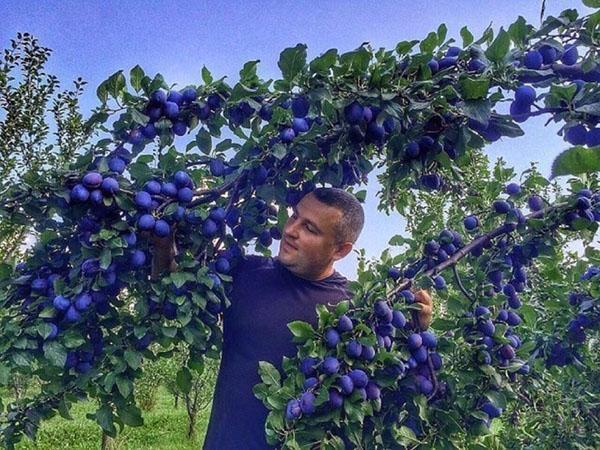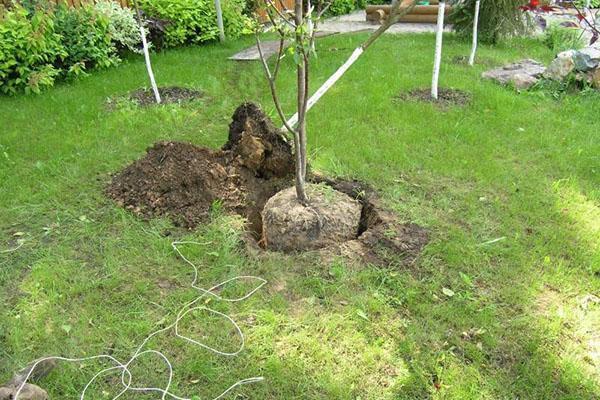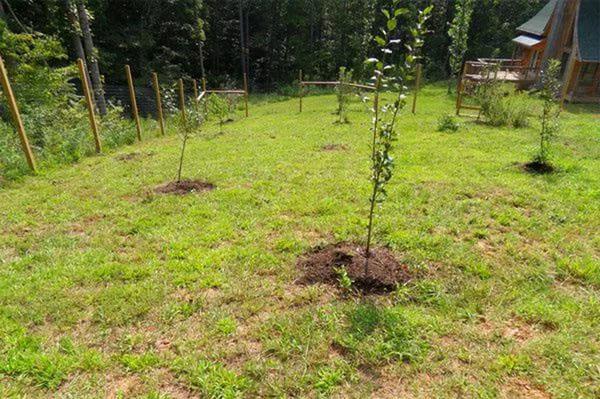Plum garden tree - planting and care
 Every summer resident dreams of planting a plum in the garden. It is believed that an unpretentious plum, anyone will take planting and care. Is it so? Among the many varieties, there is sure to be a suitable one. But there are features that, if not provided, you can hopefully expect flowering for a long time, but never try plums from your own garden. How to choose a seedling, find a place for a tree, plant and care correctly - our article.
Every summer resident dreams of planting a plum in the garden. It is believed that an unpretentious plum, anyone will take planting and care. Is it so? Among the many varieties, there is sure to be a suitable one. But there are features that, if not provided, you can hopefully expect flowering for a long time, but never try plums from your own garden. How to choose a seedling, find a place for a tree, plant and care correctly - our article.
Choosing a place for plums

Plum must not be planted where a freshly uprooted garden grew. A deposit of land should gain strength and nutrition for at least 4 years. The best soil for a tree is loam or sandy loam. Plum roots go deep into the depths, and they should not be washed away by groundwater. If there is a problem, you need to plant a tree on a ridge with a height of 50-70 cm, and drain the area through special ditches. After planting, the care of the plum will include a gradual annual expansion by 10-15 cm of the radius of the flower bed - a place for roots.
 For good yields, you need to plant plums of different varieties that are compatible for pollination. Place trees at a distance of at least 3 meters. There should be no shading plantings nearby.
For good yields, you need to plant plums of different varieties that are compatible for pollination. Place trees at a distance of at least 3 meters. There should be no shading plantings nearby.
Dig up the area where the plum will grow as deep as possible. Ideally, 70 cm. This technique is used to saturate the earth with air. The place under the plum begins to be prepared 2-3 years before planting the tree.
If the earth is acidic, it is lime. In addition to lime, sand is added to the peat soil, ash... To restore fertility, the application of organic fertilizers after their processing with EM-1 Baikal is suitable. Planting plums and leaving, after preparing the place, will not cause difficulties.
How to choose the right seedlings
 The gardener has three ways to acquire planting material:
The gardener has three ways to acquire planting material:
- In a nursery where you can buy varietal seedlings and pollinators. There you can also get the necessary advice on the characteristics of the variety, and how to plant a plum. When choosing a seedling, be guided by the presented picture. If it is possible to choose a plant with an open root or in a container, it is better to take an open one. It clearly shows all the nuances of development. The root should be in a clay mash.
- You can get free planting material using cuttings. Take young twigs that had time to turn red from the mother plant, carefully separate and hold in water for 10 days. Callus will appear. Root the twigs in a substrate of sand and peat, watered with phosphated water. The roots will grow in 10-40 days. By the time of the onset of stable frost, sprinkle the shoots peat completely and leave for the winter.
- Grow a seedling from a seed.
 Any seedling should be no more than 2 years old. When planting, the buds should be swollen, but not open. It is impossible to buy a seedling with dry buds in the spring - it got into frost. Autumn planting is carried out 1.5 months before persistent frosts.
Any seedling should be no more than 2 years old. When planting, the buds should be swollen, but not open. It is impossible to buy a seedling with dry buds in the spring - it got into frost. Autumn planting is carried out 1.5 months before persistent frosts.
In the fall, the seedling is not cut. In the spring, you need to shorten the branches so that the weak root system can feed a small amount of ground mass. The rule is that the weaker the root system of the seedling, the more you need to cut off the shoots, while forming the crown.
 The fruit pit is prepared in advance, filled with a substrate of humus, phosphorus-potassium fertilizers and half of the fertile land. The roots are placed on a mound and carefully covered on top with ordinary top soil. In doing so, the soil is compacted to displace air. The root collar should remain above the planting level, but be powdered. Later the tree will settle. After planting, several buckets of water are poured into a fresh hole and mulched. On the north side, a stake is installed to which the seedling is tied. Plum care after planting consists in timely watering and loosening the soil.
The fruit pit is prepared in advance, filled with a substrate of humus, phosphorus-potassium fertilizers and half of the fertile land. The roots are placed on a mound and carefully covered on top with ordinary top soil. In doing so, the soil is compacted to displace air. The root collar should remain above the planting level, but be powdered. Later the tree will settle. After planting, several buckets of water are poured into a fresh hole and mulched. On the north side, a stake is installed to which the seedling is tied. Plum care after planting consists in timely watering and loosening the soil.
Spring plum care
 In the spring, not only trees wake up, but also insect pests, disease spores. Therefore, care for plums in spring begins with preventive spraying with copper sulfate. The first spraying can be carried out with nitrofen to destroy hibernating mites. In addition, trapping belts are installed, tree trunks are whitewashed with the addition of insecticides to lime. To protect the plum, a fourfold treatment with copper sulfate with a strength of 1% is required:
In the spring, not only trees wake up, but also insect pests, disease spores. Therefore, care for plums in spring begins with preventive spraying with copper sulfate. The first spraying can be carried out with nitrofen to destroy hibernating mites. In addition, trapping belts are installed, tree trunks are whitewashed with the addition of insecticides to lime. To protect the plum, a fourfold treatment with copper sulfate with a strength of 1% is required:
- swollen kidneys;
- along the green cone;
- by flower buds;
- one week after flowering.
Preventive treatments are carried out to destroy pest colonies that winter in the garden.
 In order for the tree to direct its forces on the formation of the crop, pruning of plums is carried out in the spring according to the scheme for a young and fruit tree. The purpose of cutting a seedling is the correct formation of the crown, the creation of the correct ratio of the central shoot and fruit tiers. In this case, skeletal branches are formed, unnecessary inter-tiered formations are removed. Pruning is done in such a way as to make the dormant buds work, because the entire crop occurs only on young growth.
In order for the tree to direct its forces on the formation of the crop, pruning of plums is carried out in the spring according to the scheme for a young and fruit tree. The purpose of cutting a seedling is the correct formation of the crown, the creation of the correct ratio of the central shoot and fruit tiers. In this case, skeletal branches are formed, unnecessary inter-tiered formations are removed. Pruning is done in such a way as to make the dormant buds work, because the entire crop occurs only on young growth.
The mature plum is subject to sanitary and thinning pruning. After spring formation, the sparrow should fly in a straight line in all directions through the branches.
The tree has just started sap flow, and a portion of natural organic matter was introduced into the trunk circle of an adult tree. Plum maintenance in spring ensures the tree's strength after wintering. Therefore, feeding and abundant spring watering - the necessary measures. When watering, add ammonium nitrate to calculate the matchbox on a bucket of irrigation water. A careful attitude to the tree will save it from weevils and other misfortunes.
Plum tree care after flowering
 To form a harvest, the tree needs to process the food received into the characteristic set of organic and mineral ingredients that make up the cream. How to feed the plum after flowering? Natural organic matter, green broths poured into the trunk circle will help feed the roots. Prepare a mixture of 2 tablespoons of urea and 3 nitrophosphates per bucket of water. Each fruit tree requires 25 liters. At the same time, abundant watering of the tree continues.
To form a harvest, the tree needs to process the food received into the characteristic set of organic and mineral ingredients that make up the cream. How to feed the plum after flowering? Natural organic matter, green broths poured into the trunk circle will help feed the roots. Prepare a mixture of 2 tablespoons of urea and 3 nitrophosphates per bucket of water. Each fruit tree requires 25 liters. At the same time, abundant watering of the tree continues.
 How to care for plums in August? A month before harvesting, the trees are fed with a mixture that prepares the plum for winter. 4 buckets of top dressing are poured under each bush. Add 2 tablespoons of potassium sulfate, 3 tablespoons of superphosphate to the bucket. Nitrogen at this time is harmful to the tree, and watering continues.
How to care for plums in August? A month before harvesting, the trees are fed with a mixture that prepares the plum for winter. 4 buckets of top dressing are poured under each bush. Add 2 tablespoons of potassium sulfate, 3 tablespoons of superphosphate to the bucket. Nitrogen at this time is harmful to the tree, and watering continues.
All my life I have been living in the country, doing gardening and still in search of the perfect plum variety. So far my favorite is the White Honey plum variety, but I'm still looking for it. Who can recommend a similar variety and, please, with a link where you can buy it. Usually I buy seedlings from an online store, it suits me, but I am one of those people who do not mind trying new things. In general, if someone can share advice, I would be grateful. Thank you in advance